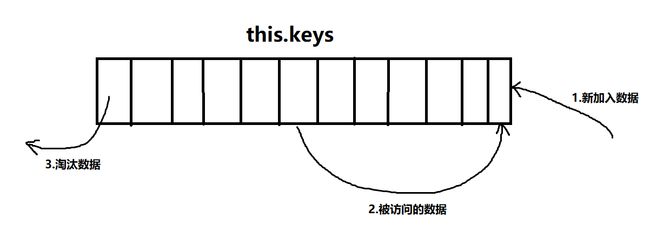【vue】通俗易懂了解keep-alive实现原理
前言
是Vue中内置的一个抽象组件,它自身不会渲染一个DOM元素,也不会出现在父组件链中。当它包裹动态组件时,会缓存不活动的组件实例,而不是销毁它们。
以上摘抄自vue官网,可以看出来,keep-alive是用来缓存组件的,比如我们有个列表页,在点击详情页之后,如果返回之后不想刷新列表页,就可以用keep-alive组件进行缓存。除此以外,还有很多应用场景。下面我们先了解下它的用法,然后再了解它的原理。
另外,本期博客参与了【新星计划】,还请大家三连支持一下感谢感谢
目录
用法
原理
created与destroyed钩子
render钩子
mounted钩子
最后
用法
我们想要缓存某个组件,只要用
比如常在router.js路由表里定义好哪些页面需要缓存,就可以通过下面这样实现了:
{
path: "/index",
name: 'index',
component: () => import(/* webpackChunkName: "index" */ '@/pages/index'),
meta: {
title: '首页',
keepAlive: true
},
},
include- 字符串或正则表达式。只有名称匹配的组件会被缓存。exclude- 字符串或正则表达式。任何名称匹配的组件都不会被缓存。max- 数字。最多可以缓存多少组件实例。
include 和 exclude 属性允许组件有条件地缓存。二者都可以用逗号分隔字符串、正则表达式或一个数组来表示:
注意:想要缓存的组件一定要给定name属性,并且要和include,exclude给定的值一致
原理
既然它也是个组件,咱先直接贴出来组件源码,看看有什么,有哪些IO(输入输出),然后再分析其原理。
export default {
name: 'keep-alive',
abstract: true,
props: {
include: [String, RegExp, Array],
exclude: [String, RegExp, Array],
max: [String, Number]
},
created () {
this.cache = Object.create(null)
this.keys = []
},
destroyed () {
for (const key in this.cache) {
pruneCacheEntry(this.cache, key, this.keys)
}
},
mounted () {
this.$watch('include', val => {
pruneCache(this, name => matches(val, name))
})
this.$watch('exclude', val => {
pruneCache(this, name => !matches(val, name))
})
},
render() {
/* 获取默认插槽中的第一个组件节点 */
const slot = this.$slots.default
const vnode = getFirstComponentChild(slot)
/* 获取该组件节点的componentOptions */
const componentOptions = vnode && vnode.componentOptions
if (componentOptions) {
/* 获取该组件节点的名称,优先获取组件的name字段,如果name不存在则获取组件的tag */
const name = getComponentName(componentOptions)
const { include, exclude } = this
/* 如果name不在inlcude中或者存在于exlude中则表示不缓存,直接返回vnode */
if (
(include && (!name || !matches(include, name))) ||
// excluded
(exclude && name && matches(exclude, name))
) {
return vnode
}
const { cache, keys } = this
const key = vnode.key == null
// same constructor may get registered as different local components
// so cid alone is not enough (#3269)
? componentOptions.Ctor.cid + (componentOptions.tag ? `::${componentOptions.tag}` : '')
: vnode.key
if (cache[key]) {
vnode.componentInstance = cache[key].componentInstance
// make current key freshest
remove(keys, key)
keys.push(key)
} else {
cache[key] = vnode
keys.push(key)
// prune oldest entry
if (this.max && keys.length > parseInt(this.max)) {
pruneCacheEntry(cache, keys[0], keys, this._vnode)
}
}
vnode.data.keepAlive = true
}
return vnode || (slot && slot[0])
}
}可以看到,正如上文所属,它有3个属性,即有3个props,下面的具体实现代码里要用到。
继续看,它有created,destroyed,mounted,render四个钩子。接下来我们就说说这四个钩子分别干了什么,最后再总结下整体流程。
created与destroyed钩子
created钩子会创建一个cache对象,用来作为缓存容器,保存vnode节点。
destroyed钩子则在组件被销毁的时候清除cache缓存中的所有组件实例。
created () {
this.cache = Object.create(null)
this.keys = []
},
destroyed () {
for (const key in this.cache) {
pruneCacheEntry(this.cache, key, this.keys)
}
},render钩子
重点来了,keep-alive实现缓存的核心代码就在这个钩子函数里。
1. 先获取到插槽里的内容
2. 调用getFirstComponentChild方法获取第一个子组件,获取到该组件的name,如果有name属性就用name,没有就用tag名。
/* 获取该组件节点的名称 */
const name = getComponentName(componentOptions)
/* 优先获取组件的name字段,如果name不存在则获取组件的tag */
function getComponentName (opts: ?VNodeComponentOptions): ?string {
return opts && (opts.Ctor.options.name || opts.tag)
}3. 用获取到的name和传入的include,exclude属性进行匹配,如果匹配不成功,则表示不缓存该组件,直接返回这个组件的 vnode,否则的话走下一步缓存:
匹配:
const { include, exclude } = this
/* 如果name与include规则不匹配或者与exclude规则匹配则表示不缓存,直接返回vnode */
if (
(include && (!name || !matches(include, name))) ||
// excluded
(exclude && name && matches(exclude, name))
) {
return vnode
}4. 缓存机制:用拿到的name去this.cache对象中去寻找是否有该值,如果有则表示该组件有缓存,即命中缓存:
缓存的处理:
/* 如果命中缓存,则直接从缓存中拿 vnode 的组件实例 */
if (cache[key]) {
vnode.componentInstance = cache[key].componentInstance
/* 调整该组件key的顺序,将其从原来的地方删掉并重新放在最后一个 */
remove(keys, key)
keys.push(key)
}
/* 如果没有命中缓存,则将其设置进缓存 */
else {
cache[key] = vnode
keys.push(key)
/* 如果配置了max并且缓存的长度超过了this.max,则从缓存中删除第一个 */
if (this.max && keys.length > parseInt(this.max)) {
pruneCacheEntry(cache, keys[0], keys, this._vnode)
}
}
/* 最后设置keepAlive标记位 */
vnode.data.keepAlive = true命中缓存时会直接从缓存中拿 vnode 的组件实例,此时重新调整该组件key的顺序,将其从原来的地方删掉并重新放在this.keys中最后一个。
如果没有命中缓存,即该组件还没被缓存过,则以该组件的key为键,组件vnode为值,将其存入this.cache中,并且把key存入this.keys中。此时再判断this.keys中缓存组件的数量是否超过了设置的最大缓存数量值this.max,如果超过了,则把第一个缓存组件删掉。
那么问题来了:为什么要删除第一个缓存组件并且为什么命中缓存了还要调整组件key的顺序?
这其实应用了一个缓存淘汰策略LRU:
LRU(Least recently used,最近最少使用)算法根据数据的历史访问记录来进行淘汰数据,其核心思想是“如果数据最近被访问过,那么将来被访问的几率也更高”。
LRU算法如下:
-
将新数据从尾部插入到
this.keys中; -
每当缓存命中(即缓存数据被访问),则将数据移到
this.keys的尾部; -
当
this.keys满的时候,将头部的数据丢弃;
mounted钩子
在这个钩子函数里,调用了pruneCache方法,以观测 include 和 exclude 的变化。
如果include 或exclude 发生了变化,即表示定义需要缓存的组件的规则或者不需要缓存的组件的规则发生了变化,那么就执行pruneCache函数,函数如下::
function pruneCache (keepAliveInstance, filter) {
const { cache, keys, _vnode } = keepAliveInstance
for (const key in cache) {
const cachedNode = cache[key]
if (cachedNode) {
const name = getComponentName(cachedNode.componentOptions)
if (name && !filter(name)) {
pruneCacheEntry(cache, key, keys, _vnode)
}
}
}
}在该函数内对this.cache对象进行遍历,取出每一项的name值,用其与新的缓存规则进行匹配,如果匹配不上,则表示在新的缓存规则下该组件已经不需要被缓存,则调用pruneCacheEntry函数将其从this.cache对象剔除即可。
最后
另外,组件一旦被 created、mounted 等钩子函数。使用keepalive组件后,被缓存的组件生命周期会多activated和deactivated 两个钩子函数,它们的执行时机分别是
看到这里,想必大家已经明白了keep-alive组件的原理了~
